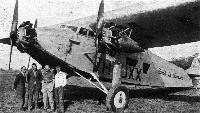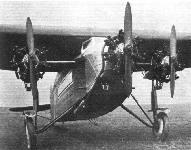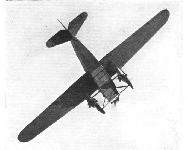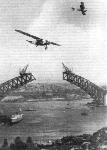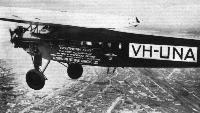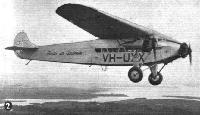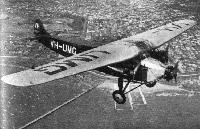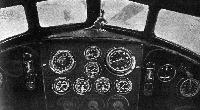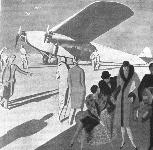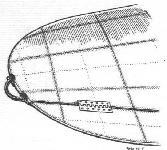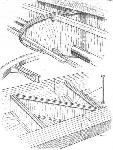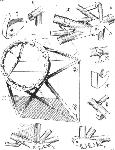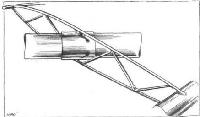
Описание
Страна : Великобритания
Год : 1928
Пассажирский самолет с двумя членами экипажа
Варианты
- Fokker - F.VII / C-2 / F.XIV - 1924 - Нидерланды
- Fokker/Atlantic - F.10 / C-5 Super Trimotor - 1927 - США
- Avro - Ten / Type 618 - 1928 - Великобритания
- Avro - Five / Type 619 / Six / Type 624 - 1929 - Великобритания
Avro серий 618 Ten, 619 Five, 624 Six и 642 Eighteen
Avro серии 618 Ten появился в результате лицензионного соглашения 1928 года на выпуск в Британии очень удачного трехмоторного авиалайнера Fokker F.VIIB-3m. Соглашение "Avro" с "Fokker" позволило британской компании продавать самолет в странах Британского Содружества, кроме Канады. Название Ten ("Десять") было принято, чтобы отразить, что самолет вмещает двух членов экипажа и восемь пассажиров.
После небольших изменений конструкции фюзеляжа Ten показали на авиационной выставке 1929 года в Олимпии, позднее он стал первой из пяти машин, проданной авиакомпании "Australian National Airways". Еще две купила фирма "Queensland Air Navigation Co. Ltd". Последний из уцелевших в Австралии самолетов в 1941 году эвакуировал людей с Новой Гвинеи. Несмотря на проявленный "героизм", самолет вскоре списали.
Пять машин серии 618 Ten продали британским авиакомпаниям: по два - фирмам "Imperial Airways" и "Airwork" и один - фирме "Midland & Scottish Air Ferries".
Последний серийный Ten в июле 1936 года попал в звено по испытанию беспроводной связи авиационного оборудования Королевского НИИ авиации, позже на нем установили однолонжеронное крыло.
Варианты
<...>
Серия 642 Eighteen: вариант Fokker F. VIIB-3m (назывался Eighteen только в начале своего появления) сочетал в себе крыло от серии 618 с новым фюзеляжем
ТАКТИКО-ТЕХНИЧЕСКИЕ ХАРАКТЕРИСТИКИ
Avro серии 618 Ten
Тип: пассажирский самолет с двумя членами экипажа
Силовая установка: три звездообразных двигателя Armstrong Siddeley Lynx IVC, каждый мощностью 240л.с.(179 кВт)
Характеристики: максимальная скорость 185 км/ч на оптимальной высоте; крейсерская скорость 161 км/ч на оптимальной высоте; начальная скороподъемность 206 м/мин; практический потолок 4875 м; дальность полета 655 км
Масса: пустого самолета 2731 кг; максимальная взлетная 4808 кг
Размеры: размах крыла 21,72 м; длина 14,48 м; высота 3,89 м; площадь крыла 71,72 м2
Полезная нагрузка: 8 пассажиров
Описание:
- Avro серий 618 Ten, 619 Five, 624 Six и 642 Eighteen
- Flight, June 1929
BRITISH AIRCRAFT AT OLYMPIA
Фотографии
-
Мировая Авиация 39
Регистрационный номер: G-AASP Avro серии 618 получил название Ten, поскольку был рассчитан на восемь пассажиров и двух членов экипажа. "Imperial Airways" получила первый самолет в 1930 году, эти машины использовались в основном для чартерных рейсов на европейских маршрутах.
-
Flight 1929-07 / Flight
AVRO 10 (3 Armstrong Siddeley "Lynx").
-
Flight 1929-10 / Flight
An Avro X (3 "Lynx"), of which several are to be put into service in Australia.
-
Flight 1929-07 / Flight
On the Avro Stand: In the foreground the Avro 10; on the left the Avro 5, and on the right the "Avian" with "Genet Major" engine.
Другие самолёты на фотографии: Avro Avian / Type 594/616 - Великобритания - 1926
-
Flight 1933-10 / Flight
Регистрационный номер: VH-UXX [4] ANOTHER ENGLAND-AUSTRALIA FLIGHT: C. T. P. Ulm (second from left) and his companions, Allan, Edwards and Taylor, and the Avro X in which they are flying to Australia - hoping to better Kingsford-Smith's time.
-
Flight 1933-10 / Flight
Регистрационный номер: VH-UXX [4] The Faith in Australia and her crew, including Mr. Edwards (white sweater), wireless operator, who did not accompany Mr. Ulm!
-
Flight 1933-09 / Flight
Регистрационный номер: VH-UXX [4] READY TO TRY AGAIN: Mr. C. T. Uhn is ready to make another attempt to fly the Atlantic in the Avro 10 Faith in Australia, which has now been repaired by A. V. Roe, Ltd., at their Manchester works. Our picture shows the machine and its crew - reading from left to right, Messrs. Allen, Ulm, Taylor and Edwards.
-
Flight 1929-11 / Flight
FRONT VIEW OF THE AVRO TEN: Three Armstrong Siddeley "Lynx" Engines.
-
Flight 1929-11 / Flight
The Avro Ten: A close-up of the nose showing the three "Lynx" engines. Wheel brakes are fitted to the landing wheels.
-
Flight 1931-11 / Flight
Регистрационный номер: VT-ACT FOR THE VICEROY OF INDIA: The Avro 10 which left Croydon for India, piloted by Mr. Nevill Vincent, on Nov. 20. This machine is intended for the personal use of Lord Willingdon, Viceroy of India.
-
Flight 1929-11 / Flight
The Avro Ten: In the three-quarter front view the man standing in front gives "scale" to the picture.
-
Flight 1933-08 / Flight
Avro "X" (3 "Lynx") ten seater.
-
Flight 1929-11 / Flight
OFF: The Avro Ten taking off on a test flight at Woodford Aerodrome, piloted by Flight-Lieut. John Oliver, A.F.C.
-
Aeroplane Monthly 1991-02 / J.Stroud - Wings of Peace
Регистрационный номер: VH-UMF The prototype Avro Ten, which went to Australian National Airways as VH-UMF Southern Cloud.
-
Flight 1929-11 / Flight
THE AVRO 10: Another type of three-engined monoplane, added to the fleet in 1931.
-
Flight 1930-08 / Flight
MISS JOHNSON AT SYDNEY: An "impression" of Miss Amy Johnson flying over the Sydney Harbour Bridge (under construction) in the National Airways Avro 10, on June 4
-
Flight 1931-12 / Flight
Регистрационный номер: VH-UNA [2] THE START: The Avro 10 (Armstrong-Siddeley "Lynx"), "Southern Sun," leaving Melbourne for England with mail on November 20. Six days later it crashed at Alor Star, and the mails - together with this and accompanying illustration - were brought on by Kingsford Smith in the "Southern Star."
-
Aeroplane Monthly 1991-02 / J.Stroud - Wings of Peace
Регистрационный номер: VH-UNA [2] ANA's Avro Ten Southern Sun leaving Melbourne on the first all-Australian mail flight to the United Kingdom.
-
Flight 1936-01 / Flight
Регистрационный номер: VH-UXX [4] Faith in Australia, the veteran Avro Ten of Tasman Sea fame, over Auckland.
-
Flight 1933-12 / Flight Advertisements
Регистрационный номер: VH-UMG [7] THE AVRO TEN FITTED WITH 215 H.P. LYNX ENGINES OPERATING ON THE AUSTRALIA - TASMANIA SERVICE
-
Flight 1933-10 / Flight
Регистрационный номер: VH-UMG [7] ON TASMANIAN SERVICE: The Avro "Ten" operated by Hart Aircraft Co., Ltd., on their Melbourne - Launceston service flying over Melbourne. The Hart Aircraft Company, whose offices and hangars are located at Essendon Aerodrome, Melbourne, operate as well as the Melbourne - Launceston service, a general aircraft engineering service, a taxi service throughout the Commonwealth of Australia and a school of aviation. Their flying equipment consists of the Avro "Ten" (three-engined monoplane), a Desoutter ("Gipsy Mark III"engine), a "Hawk Moth" with a geared "Lynx" engine, and two "Gipsy Moths."
-
Aeroplane Monthly 1984-05 / J.Stroud - Wings of Peace
Регистрационный номер: VH-UMG [7] The Avro Ten VH-UMG was Australian National Airways’ Southern Star. It passed to Hart Aircraft and then Australian Transcontinental Airways.
-
Aeroplane Monthly 1987-03 / K.Durdey - An Australian air knight
Регистрационный номер: VH-UMG [7] The arrival of the Southern Star, Avro Ten VH-UMG, in which Kingsford Smith delivered Christmas mail from Australia to Croydon in December 1931.
-
Flight 1931-12 / Flight
Регистрационный номер: VH-UMG [7] THE ARRIVAL: The Southern Star, which, piloted by Air-Commodore Kingsford Smith, brought on the mails from the Southern Sun, arrives at Croydon on December 16.
-
Aeroplane Monthly 1985-10 / Personal album
Регистрационный номер: VH-UMG [7] Australian National Airways Avro Ten (licence-built Fokker F.VIIb-3m) VH-UMG Southern Star at Bangkok in January 1932. On November 20, 1931, Southern Sun had left Sydney on the first all-Australian mail flight to England, but it was wrecked at Alor Star. Charles Kingsford Smith then flew to Alor Star in Southern Star to pick up the mail and fly it to Croydon. Kingsford Smith and G. U. Allan left Hamble on the return flight on January 7, 1932, Siamese air force picture was taken during the return journey. Included in the photograph with Kingsford Smith are Siamese officials and Robert Cain, who later escaped from Siam at the time of the Japanese invasion of that country, returned to England and joined the Parachute Regiment. Later he won the Victoria Cross at Arnhem.
-
Flight 1931-12 / Flight
A close-up of the Southern Star (top) and (below) its cargo of Xmas mail from New Zealand and Australia.
-
Flight 1932-05 / Flight
H.E. The Viceroy and Lady Willingdon arrived by aeroplane at Peshawar on the 16th April, to install the new Governor of Province (Sir Ralph Griffiths), and to inaugurate the new Legislative Council. In the photo are seen Lord Willingdon, shaking hands with Lady Griffiths. Lady Willingdon has just descended from the Avro 10 and is going to shake hands with Sir Ralph Griffiths (Chief Commissioner of the North-West Frontier Province and Governor Designate).
-
Aeroplane Monthly 1988-02 / Personal album. Civil
Регистрационный номер: G-ABLU [3] Avro Ten G-ABLU, named Apollo for Imperial Airways was used for general charter work, replacing Avro Ten G-AASP Achilles for use by the Iraq Petroleum Company Ltd on desert pipeline patrol work. After a period in the Near East it returned to the UK in 1933 for use on European charter work, based at Le Bourget, was written off on December 30, 1938.
-
Flight 1931-07 / Flight
Регистрационный номер: G-ABLU [3] FOR IMPERIAL AIRWAYS: The second of the Avro 10 three-engined (Armstrong-Siddeley commercial monoplanes which have been supplied to Imperial Airways Ltd.
-
Aeroplane Monthly 1985-12 / J.Stroud - Wings of Peace
Регистрационный номер: G-ABLU [3] Imperial Airways’ charter fleet line-up at Croydon in 1933. Right to left: Westland Wessex G-ACHI and G-AAGW, Avro Ten G-ABLU Apollo, and Desoutter I ambulance G-ABMW Air Taxi No.6.
Другие самолёты на фотографии: Koolhoven FK-41 - Нидерланды - 1928Westland Wessex / Westland IV - Великобритания - 1929
-
Air Enthusiast 2000-11 / G.Warner - Founding Fathers (2)
Регистрационный номер: G-ACGF Avro 618 Ten G-ACGF of Midland and Scottish Air Ferries Ltd.
-
Flight 1933-10 / Flight Advertisements
SMITH'S INSTRUMENTS FITTED TO "FAITH IN AUSTRALIA" INCLUDING TURN & BANK INDICATOR FOR HIS RECORD FLIGHT ENGLAND - AUSTRALIA IN 6 DAYS 18 HOURS
-
Aeroplane Monthly 1991-02 / J.Stroud - Wings of Peace
The cabin of one of Imperial Airways’ Avro Tens.
-
Flight 1933-08 / Flight
"I WANT TO BE A SEAPLANE!" Mr. Ulm's Avro 10 monoplane caught by the tide at Portmarnock Strand, Dublin, when its undercarriage collapsed after being refuelled.
-
Aeroplane Monthly 1993-04 / C.Prower - From Brisfit to Beverley (1)
Регистрационный номер: VH-UMG [7] Avro Ten Southern Star after it crashed into an orchard at Crockenhill, Kent on December 21, 1932.
-
Flight 1929-07 / Flight
The wing tips of the Avro 10 and 5 have hand grips for steadying machines on ground. The illustration also shows plywood planking and aileron hinge.
-
Flight 1929-07 / Flight
Details of the all-wood wing construction on the Avro 10 and 5.
-
Flight 1929-11 / Flight
AVRO WELDED STEEL TUBE CONSTRUCTION: Circular engine mountings of the type shown in 1 are used both for fuselage and wing engines, but the actual supports of the rings differ slightly. The joint to the top longeron is shown in 2, with end fitting before welding shown at A and B. The fitting at the lower longerons is illustrated in 3, with details in 3C. The type of cowling support and attachment is shown in 4. In 5 is shown engine bracket before it is welded on to the engine ring, and 6 shows a bracket, a portion of the ring, and the attachment of a cowling tube.
-
Flight 1929-11 / Flight
AVRO WELDED CONSTRUCTION: A typical fuselage joint.
-
Flight 1929-11 / Flight
AVRO WELDED CONSTRUCTION: In the tail plane use is made of internal diagonal tubular struts of high-tensile steel. To avoid welding direct to this, mild-steel sleeves are used, as shown. The sketch also illustrates the welded tube tailplane ribs, the web being formed of continuous tubes welded to the flange booms.
-
Flight 1929-07 / Flight
Avro X 3 Armstrong Siddeley "Lynx" Engines
- Фотографии





